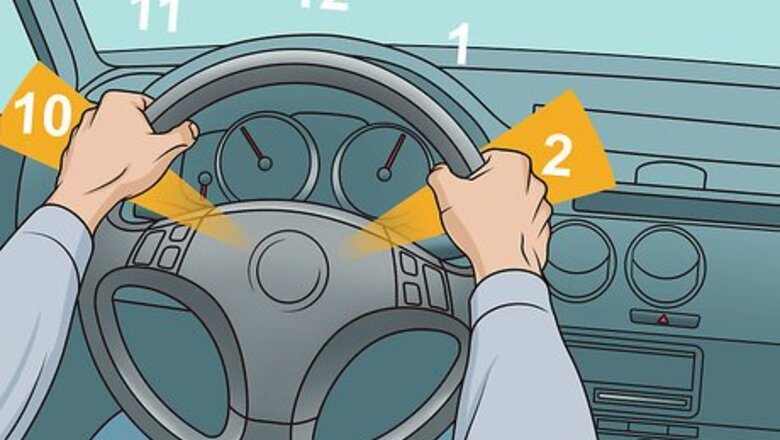
views
Getting Out Quickly
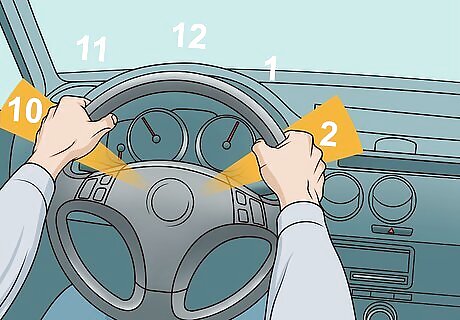
Brace yourself for impact if you’re the driver. As soon as you're aware that you're going off the road and into a body of water, adopt a brace position. If you’re driving the car, place both hands on the steering wheel in the "10 and 2" positions. The impact of your car hitting the water could set off the airbag system in your vehicle, and any other brace position could cause serious injury in such an event. Don’t try to brace yourself if you’re a passenger. Putting your head down or raising your arms could increase your chances of being injured in the crash.
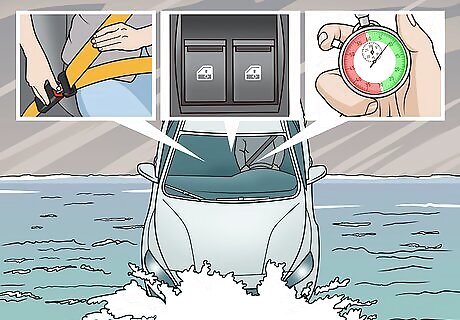
Try to remain calm and act quickly. Panic reduces energy, uses up precious air, and causes you to blank out. As soon as you see that you are about to head into a body of water, take a couple of deep breaths and tell yourself “I need to stay focused and act immediately.” Focus on what is happening in the moment and on the steps you will need to take to escape.Tip: Don’t call emergency services until you are out of the car. Making a call will take up precious seconds and reduce your chances of escaping. Say to yourself, “I need to unbuckle my seatbelt, open a window, and get out.” You will have only about 30-60 seconds to act before your car sinks below the water and escape becomes nearly impossible.
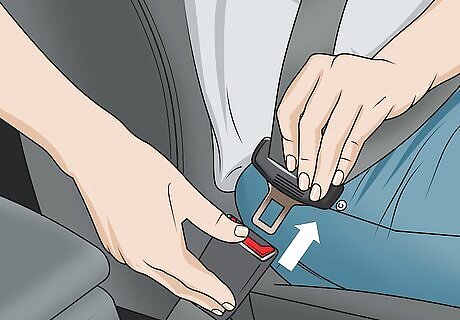
Undo your seatbelt. As soon as you hit the water, unbuckle your seatbelt. You won’t be able to exit the car if you’re strapped in. This is the first step in the S.W.O. (Seatbelts off, Window open or broken, Out (Children First)) protocol developed by car safety expert Dr. Gordon Giesbrecht. If there are children or other passengers in the car who may need help, don’t worry about unbuckling them yet. Your first priority is to unbuckle yourself so you can open up an escape route as quickly as possible.
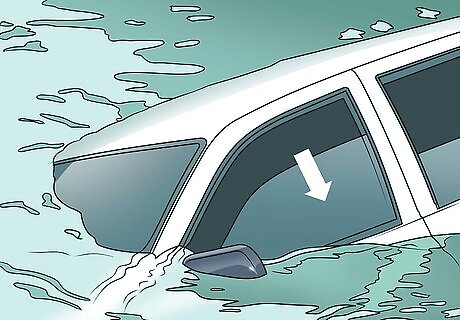
Open a window as soon as you’ve unstrapped yourself. After unbuckling your seatbelt, act quickly to open your window before the water rises above window level. Once there is water pressing against the window, it will become nearly impossible for you to open or break it. If your car has electrical windows, they should continue to function for a few minutes after you enter the water. Don’t try to escape through a door. The pressure of the water outside the door will make it nearly impossible to open within a few seconds of impact with the water. Even if you do manage to open the door, it will cause the car to flood with water and sink more quickly.
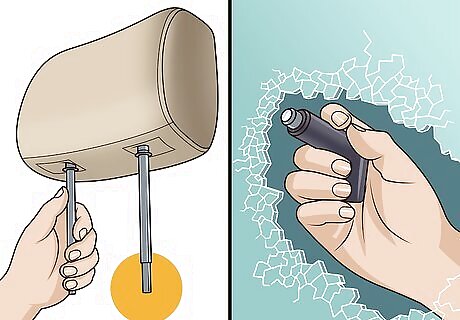
Break a window if you can’t open one. If you aren't able to open the window, or if it only opens halfway, you'll need to break it. If you don’t have a glass-breaking tool (such as a center punch or a glass-breaking hammer) on hand, remove a headrest from one of the seats and strike the lower corner of a window several times with the tongs on the bottom. Since the front of the car is heaviest and will likely sink first, don’t try to escape through the windshield. The windshield is also designed to be more difficult to break than the other windows. Instead, break the driver’s side window or a rear passenger window. If you have no tools or heavy objects to break the window with, use your feet. Kick near the front of the window or along the hinges rather than in the center.
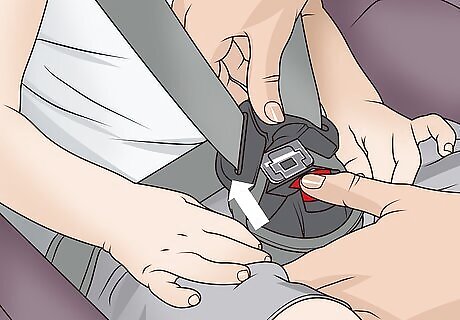
Get any children out first. If there are children in your car, unbuckle them immediately and push them out through the open window. It will be easier for you to get them out and then follow them than it would be for you to come back and rescue them after getting yourself out. If there are multiple kids in the car, start by helping the oldest one. They may be able to help the younger kids get to safety.
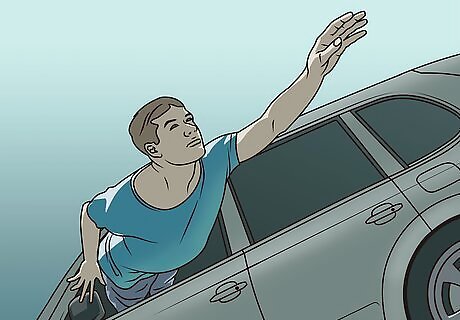
Escape through the opened or broken window. Once the window is open and you’ve gotten any children out, climb out as quickly as you can. Your car may already be filling with water and sinking fast at this point, so be prepared to swim up and out through the window. If you have to swim to get out, do not kick your feet until you’re clear of the car—you could injure other passengers. Use your arms to propel you upward.
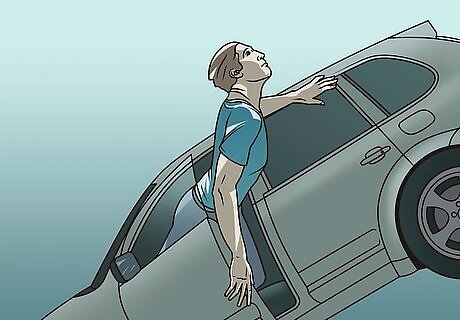
Try to open a door if the car is submerged. If you’re not able to open a window before the car sinks, you may still be able to escape through a door. Take a few slow, deep breaths while there is still air in the car, then unlock the nearest door. People are commonly told to wait until the car fills completely with water in order for the pressure inside and outside of it to equalize, at which point you will supposedly be able to open the door. But Mythbusters and Top Gear have tested this theory and found it wanting. The inside and outside pressure will eventually equalize, but it won’t happen just as soon as the car fills up with water. It takes a bit longer, so long that you’ll likely drown before it happens. It is possible if you are patient, calm, and conserve your oxygen, but don’t count on it. If you have to open the door, hold your breath and push hard against the door while pulling on the handle to open it, then swim up and out. It takes 60 to 120 seconds (1 to 2 minutes) for a car to fill up with water. Unfortunately, your chances of successfully escaping in this situation are very low unless you have an oxygen supply. Continue to breathe normally until the water is at chest level, then take a deep breath and hold your nose. Stay calm. Keep your mouth closed to preserve your breath and to prevent water from entering. If exiting via an open door, place your hand on the door latch. If you are unable to see it, use a physical reference by stretching your hand from your hip and feeling along the door until you locate the latch.
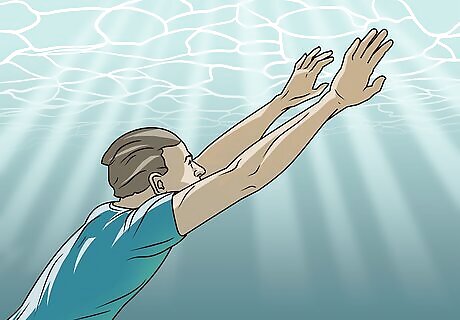
Swim to the surface as quickly as possible if you’re submerged. Push off the car and swim to the surface. If you don’t know which way to swim, look for light and swim toward it, or follow any bubbles you see as they will be going up. Be aware of your surroundings as you swim and surface; you may have to deal with a strong current or obstacles such as rocks, concrete bridge supports, or even passing boats. If it's ice-covered water, head for the obvious hole created by the car's impact. Do your best to avoid injuring yourself on obstacles, and use branches, supports, and other items to cling to if you're injured or exhausted.
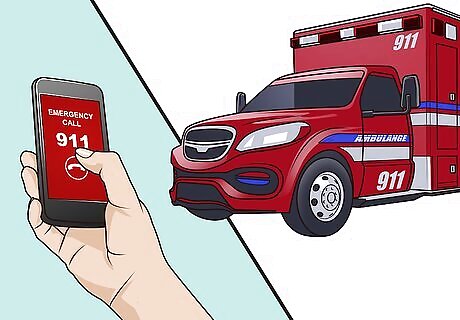
Call emergency services once you’re out. After you’ve successfully escaped the car and made it to the surface, call 911 or your local emergency number to report the accident. If you left your phone behind, hail a passing motorist who can call for help and provide you with warmth, comfort, and a lift to nearest hospital if necessary. The adrenaline in your bloodstream after the escape may make you unable to detect any injuries you may have sustained in the accident, so get a medical evaluation as soon as you can. Hypothermia may be a real possibility, depending on the water temperature, the level of shock passengers and drivers are experiencing, and the external temperature.
Creating an Escape Plan
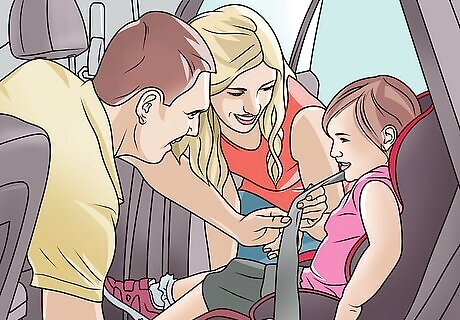
Review the S.W.O. routine with your family. You will have a better chance of successfully escaping a sinking car if you already know what to do ahead of time. Talk to your family or anyone else who rides with you routinely about the correct steps to take in a water accident. Practice this escape routine mantra:Did you know? You may occasionally come across a variant on this technique called S.C.W.O. (Seatbelts off, help Children, Window open or broken, Out). However, car safety experts now advise waiting to unbuckle children until after the window is open or broken. Seatbelts off. Window open or broken. Out (children first).
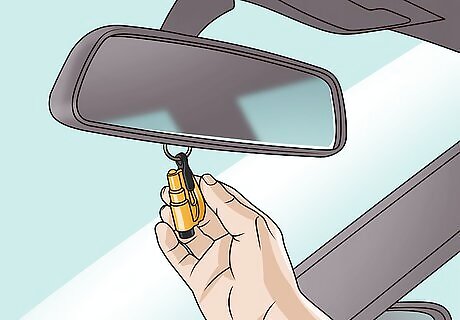
Keep a glass-breaking tool in your car. Breaking your window in the event of a water emergency will be much easier if you keep a specialized tool in an obvious and easily accessible place. Get a center punch, a glass-breaking hammer, or a glass breaking keychain (such as the ResQMe tool) and keep it with you any time you are in your car. You could hang the tool from your rearview mirror or attach it to your keychain for quick access.

Practice unbuckling your children quickly. When you’re trying to get kids out of the car in an emergency, getting their seatbelts unbuckled fast enough can be a challenge—especially if they’re in car seats. Practice unbuckling your kids as quickly as possible. Once you’re comfortable doing that, try unbuckling them with your eyes closed. You might also keep a seatbelt cutting tool on hand in case unbuckling the seatbelts is too difficult.



















Comments
0 comment